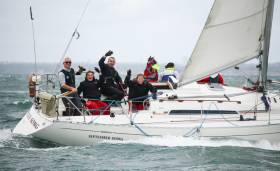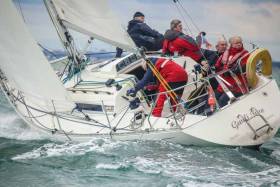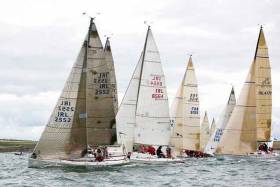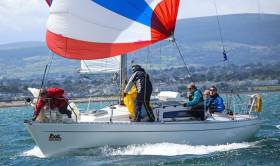Displaying items by tag: Sigma 33
Boosted DBSC Cruisers Two Class Stage Pre-Season 'Tips on Sail Trim' Talk with Des McWilliam
To mark the beginning of the new season in a revamped class, Dublin Bay Sailing Club Cruisers Two sailors are holding a pre–season supper at the Royal St George Yacht Club on Friday, 21st April.
The guest speaker is sailmaker Des McWilliam who will give 'Tips on Sail Trim' and all sailors are welcome.
Incoming Class captain Adrienne Jermyn says 'It's an exciting year for the class as we've combined Cruisers two and the Sigma 33 class which brings our fleet numbers to 19'.
Read more about class two racing in Ireland here.
The Sigma 33 may yet be the biggest one design cruiser fleet at July's Volvo Dun Laoghaire Regtta with 16 entries so far.
The long established Dublin Bay class merged with class two for local DBSC racing this year but plans to hold a special One Design Dun Laoghaire bicentennial Race Day during the four day regatta on Friday, 7th July.
Results will be based on all races sailed at the Volvo Dun Laoghaire Regatta on Friday 7th with no discards.
The prize giving will take place in the Royal Irish Yacht Club and includes a Sigma 33 class regatta dinner.
Half–Tonners, Sigma 33s, X302s, J97s & Corbys Mean ICRA Class Two Title Is Wide Open
Class Two is certainly heating up and expanding this year writes Dave Cullen, Skipper of championship winning half–tonner Checkmate XV. The quality of the fleet must make it one of the most competitive with boats ranging from €15k to €150k all in with a fighting chance of the podium.
At the bottom of the rating band, Sigma 33s make up the numbers and the top end is dominated by J97s and Elan 333s.
Such are the numbers that a number of boats might find themselves unhappy participants in Class One which happened in Sovereigns Cup two years ago.
The fleet is diverse and includes a sizeable X302 fleet from Howth YC including the stalwart podium winner DUX, Maximus and Viking to name but a few.
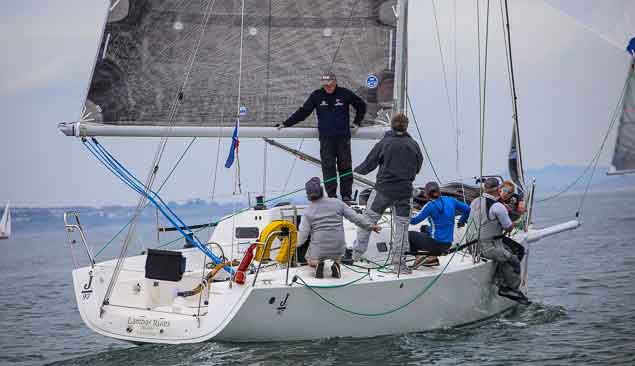 Stephen Quinn’s J/97 Lambay Rules is at the top of the Class Two Rating Band Photo: Afloat.ie
Stephen Quinn’s J/97 Lambay Rules is at the top of the Class Two Rating Band Photo: Afloat.ie
 Cork's George Radley adds his latest 'half' Half Tonner Cortegada to the Class Two fleet this season. Photo: Bob Bateman
Cork's George Radley adds his latest 'half' Half Tonner Cortegada to the Class Two fleet this season. Photo: Bob Bateman
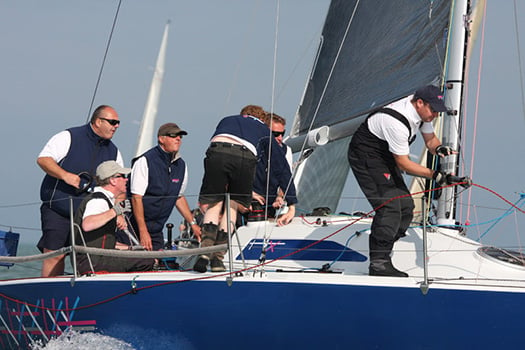 David Cullen's Checkmate from Howth Yacht Club is the 2015 Half Ton champion
David Cullen's Checkmate from Howth Yacht Club is the 2015 Half Ton champion
 Popular Half tonner Harmony from Howth (Jonny Swan) is on the Class Two circuit Photo: Bob Bateman
Popular Half tonner Harmony from Howth (Jonny Swan) is on the Class Two circuit Photo: Bob Bateman
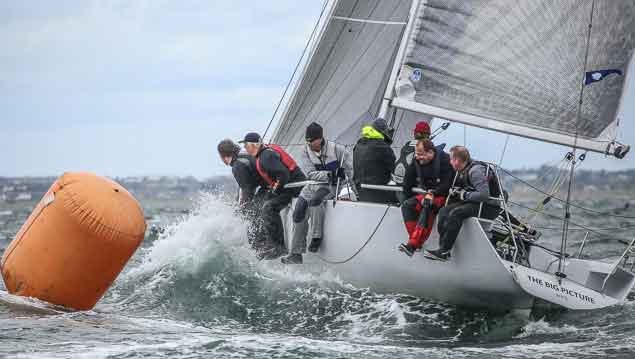 Another quality Half tonner campaign from HYC, The Big Picture (Michael and Richard Evans). Photo: Afloat.ie
Another quality Half tonner campaign from HYC, The Big Picture (Michael and Richard Evans). Photo: Afloat.ie
The Half Ton class is formidable and apart from the locals of Checkmate XV, Harmony, King One and The Big Picture, visiting boats planning on basing campaigns here include Nigel Biggs latest Checkmate XVIII ex Dick Dastardly, Paul Wayte from Swansea's HB31 Headhunter and the highly optimised Miss Whiplash returns to Dublin owned by Paul Pullen visiting from Swansea. Demolition from Falmouth is also likely to appear. George Radley adds his latest 'half' Cortegada to the pile of quality competitors.
 The X302 fleet from Howth YC includes stalwart DUX Photo: Afloat.ie
The X302 fleet from Howth YC includes stalwart DUX Photo: Afloat.ie
Throw in DB1s, J80s, Corby 25 & 26s and the start line really shapes up with a sharp competitive fleet.
It's easy to predict the half tonners as dominating with light to medium conditions suit them for sure. The same applies with the Corbys. Throw in an extra few knots and the X302s pick up their heels as do the Sigma 33s which are never too far behind. Movistar Blue and Lambay Rules like a breeze too so the field is really wide open.
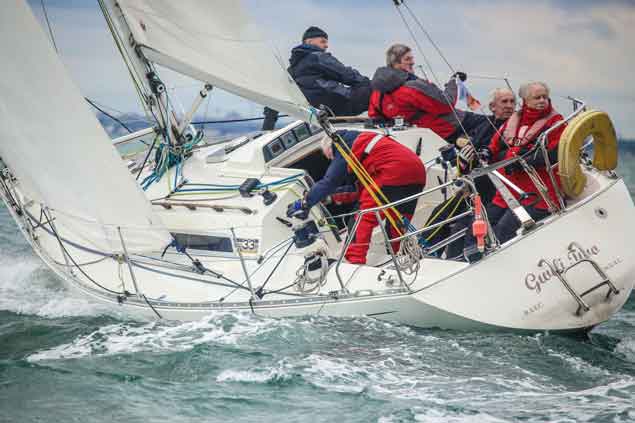 The Sigma 33 class, formerly a stand alone one design class, have joined DBSC Cruisers Two division this year, boosting numbers on Dublin Bay to 19 Photo: Afloat.ie
The Sigma 33 class, formerly a stand alone one design class, have joined DBSC Cruisers Two division this year, boosting numbers on Dublin Bay to 19 Photo: Afloat.ie
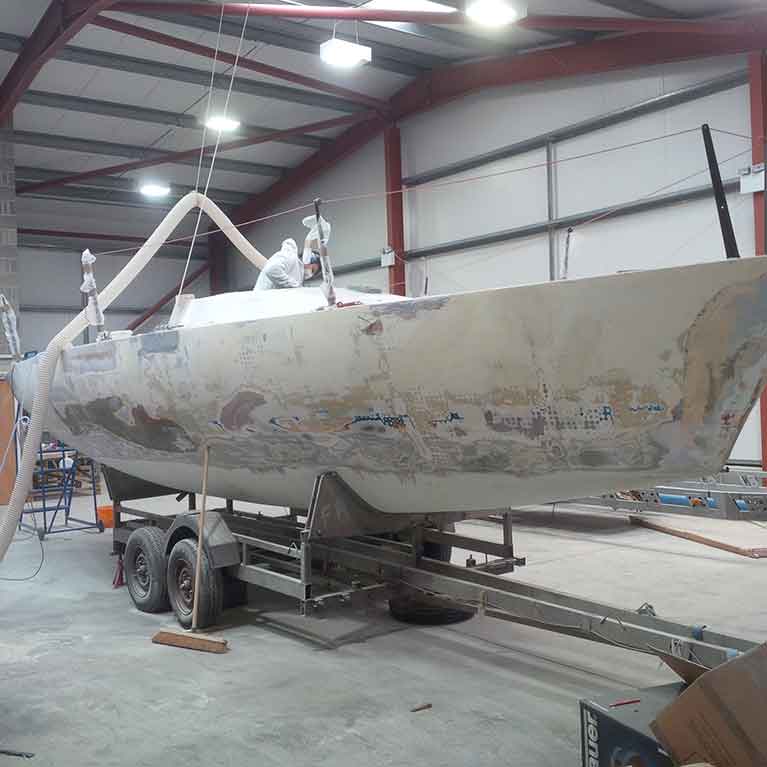 Checkmate XVIII – the old Emiliano Zapata, ex Dick Dastardly, ex French Beret, ex Concorde from 1985 is undergoing a refit in North Wales, launching early May
Checkmate XVIII – the old Emiliano Zapata, ex Dick Dastardly, ex French Beret, ex Concorde from 1985 is undergoing a refit in North Wales, launching early May
On Dublin Bay, there will be a reported 19 boats in this year's DBSC Cruisers two fleet boosted by eight Sigma 33s who join the division.
As to predictions, any of the boats in the class can win but need to arrive on the line in good shape and well prepared. Rub your hand over the bum of any of the Class leaders and you will see the efforts put in as the best winning ingredient for race wins is boat speed.
I think a prediction is futile without a weather forecast so I would say for lighter traditional Dublin summer conditions, any of the half tonners or the Corby 25 will feature in a windward–leeward race, Lambay Rules (J97) prefers a reach round the cans races whilst a well sailed Sigma 33 has a real chance if they can stop the mighty Dux in breezy conditions.
Having answered the question like a politician would, if it was predictable none of us would bother, so place your bets and see how it fared out in October. I'll put a tenner on Biggsy though!
Dave Cullen of Howth Yacht Club is Skipper of Half–Tonner Checkmate XV and won the 2015 Half Ton Classics Cup with a race to spare
Devising a New Approach to Cork Harbour Cruiser Racing
I visited my Sigma 33, appropriately named SCRIBBLER – II to be particular, as there was a previous incarnation, a Ruffian 23, which proudly bore SCRIBBLER 1. My visit was to check her out, see how she was surviving the Winter and, in the cabin for a while, to consider how much attention she will need before launching this year…..
It’s that time of year again, great as age mounts up, to have arrived into another year and to think of the season ahead and wonder what it may bring……. Will she be dressed again in full regalia, spinnaker flying, when we race or will the now annual crewing…a searching situation mean that it will be white sail only?
These are amongst my thoughts as the ISA letters and forms arrive for IRC and ECHO handicap renewals and the two clubs of which I am a member in Cork Harbour, discuss the future of cruiser racing…. The Royal Cork, RCYC, at Crosshaven is setting up a group to review cruiser racing…. The club’s Rear Admiral, Kieran O’Connell, in charge of keel boat racing, says that the decline in the number of boats racing, which had occurred over the last few seasons, appeared to have stabilised in the past year.
There is a need to devise a new approach to cruiser racing. Clubs around the country have experienced a similar downturn in the number of cruisers racing at regular club events. There are difficulties in getting crews for boats. Another problem is the ageing profile of the cruiser racing and ensuring transition of sailors from dinghies to cruisers and the modern-day demands for parents of family duties.. White sailing has counteracted some of the problem. Handling just two sails requires
less crew numbers…
My home village club, Monkstown Bay, concentrates solely on white sail and is discussing joint racing arrangements in Cork Harbour with the neighbouring Cove Sailing Club.
So the season ahead has positive aspects…And my Sigma 33 received me well on my first visit this year….though I got the impression she was saying that the visit had been too far delayed….….
Sigma 33 Class Celebrate At National Yacht Club
The Sigma 33 East Coast class Association held their Annual Dinner in the National Yacht Club on Friday, 11 November 2016 with almost 80 members present. In attendance was the Commodore of Dublin Bay Sailing Club Chris Moore, Roman Beirne Vice Commodore of the National Yacht Club and Paul Prentice, Chairman of the Sigma 33 Class Association.
Prentice announced that Dun Laoghaire would stage the Irish National Sigma 33 Championships in 2017 in conjunction with Volvo Dun Laoghaire Regatta between the 6th and 9th of July 2017.
The main prize winners last night were from Sigma 33, Rupert, Dick and Philip Lovegrove winners of “ The Coleman O’Sullivan Trophy” For Corinthian qualities. And Leeuwin, Henry Leonard and Bobby Kerr won a Model of a Sigma 33 For 'Exceptional Performance'.
Tributes were also paid to Mrs Sandra Moore the Class Secretary for almost 16 years who was now standing down. Her work over the years was acknowledged by a special presentation.
Rescue Effort Wins 2016 Round The Island Race Seamanship Award
Sacrificing his own race to go to the aid of another stricken competitor in the 2016 Round the Island Race has resulted in Jeff Warboys, skipper of a Sigma 33 Workout, being awarded the 2016 Round the Island Race Seamanship Award, sponsored by Haven Knox-Johnston.
Another competing boat, Alchemist, a Dubois half tonner, hit a submerged wreck off the Needles and was rapidly taking on water in strong winds. After making a distress call, the crew quickly dropped sails and then started bailing using the bilge pump. However, and despite their strenuous efforts, the water level rose very quickly.
On board Workout Jeff spotted the frantic activity and approached Alchemist to offer assistance. Although this was declined, as a distress call had already been made, Workout dropped its sails and continued to stand by throughout the wait for the rescue team from the RNLI. This took longer than anticipated owing to other distress calls in the area.
Those on board Alchemist expressed their sincere thanks to Jeff Warboys and his crew for offering assistance at the expense of losing out in their own race.
Thankfully, all six members of the Alchemist crew were uninjured and rescued by the Mudeford RNLI inshore lifeboat team just moments before she sank.
Given all these circumstances, Jeff and his crew still turned in a remarkable 1st in the Sigma 33 class and 9th in his group, IRC 3!
Royal Irish Sigma 33 Wins Dun Laoghaire–Greystones Race
Royal Irish Yacht Leuwin skippered by Henry Leonard was the winner of today's Sigma 33 coastal race to Greystones Harbour. Second was September Song skippered by Maurice O'Connell. Third was Dermot Clarke's Gwilli Two.
The race was led by Gwili Two at the Muglins Rock on Dublin Bay with Moonshine a close second but by Bray Head the lead had changed a number of times. By the time the fleet arrived off Greystones the first three boats in the annual 12–miler finished within a minute after 1 hour and 47 minutes of racing.
Dublin Bay Sigma 33s Ready for Coastal Race to Greystones
The Dublin Bay Sigma 33 fleet hold their coastal race tomorrow from Dun Laoghaire to Greystones marina in what is forecast to be favourable conditions for the novel race.
Up to six will compete in the 12–mile race for 'The Night Cap' Trophy presented by former Sigma 33 ace Timothy Goodbody.
On the way south the Dublin Bay based fleet will have a bird’s eye view of the Air Show over Bray, Class Captain Paddy Maguire told Afloat.ie
In last year's inaugural coastal race, Rupert (Dick & Philip Lovegrove) rounded the finish line mark only a boat length ahead of White Mischief (Tim Goodbody) after three hours of racing.
The prizegiving will be held in the new Greystones Sailing Club clubhouse.
Honouring a tradition of Belfast Lough sailing which can be traced back to its foundation in 1866 and beyond, the Royal Ulster YC at Bangor on Belfast Lough began its four week “Sesquicentennial Sailing Celebrations” over the weekend with the British & Irish Sigma 33 Championships.
Three days of good racing on the open waters of Belfast Lough were enjoyed by nineteen Sigma 33s, which continue to have significant strongholds in the Firth of Clyde, as well as enthusiastic local small groups at many other ports. Ten races were scheduled, and despite varying winds and weather over the event, all ten were fully completed by a fleet drawn from Cornwall, Liverpool, Dunmore East, the Isle of Man, Glenarm, Strangford Lough and points round the Clyde, together with Belfast Lough-based crews, for the Class’s biggest event of the year.
The racing was close such that seven races on Friday and Saturday produced six winners. Bangor based boat ‘Squawk’ (Emma and Paul Prentice) got the local fleet off to a good start with a win in Race 1. Eric Robertson and Alan Harper from Cove Sailing Club in Loch Long in Argyll won Race 2 in ‘Leaky Roof II’, and Mark Bradshaw and Jack Gallagher in ‘Busy Beaver’, also from Cove SC, took Race 3. In contention after two days was James Miller’s Mayrise from Helensburgh, the winner at the recent Silvers Scottish Series at Tarbert. Race winners on Saturday were ‘Busy Beaver’, Stephen Martin’s ‘Signet of Kip’ from Strangford Lough YC, Allan Lennox and Grant Simpson’s Miss Behavin from Helensburgh SC, and Griogair Whyte’s Close Encounters from Royal Northern and Clyde YC.
Signet of Kip (SLYC) was winner of the Irish Sigma 33 Championship – this is Stephen Martin and his crew from Strangford Lough YC
Sunday saw three races sailed in the only damp weather of the series, and the Bradshaw/Gallagher team on Busy Beaver continued in good form, taking honours in Races 8 & 9. It was left to the Class Chairman, Paul Prentice, and his crew in Squawk to finish the event the way they had started, with the win in Race 10.
SIGMA 33 UK CHAMPIONSHIP WINNER: Busy Beaver (Mark Bradshaw & Jack Gallagher), Cove Sailing Club, Loch Long
Runner Up: Mayrise (James Miller) Helensburgh Sailing Club.
IRISH SIGMA 33 CHAMPIONSHIP WINNER: Signet of Kip – Stephen Martin (Strangford Lough Yacht Club)
Runner Up: Squawk (Emma and Paul Prentice) Royal Ulster Yacht Club/Ballyholme Yacht Club.
The RUYC 150th Anniversary Programme continues this weekend with a thee day Classics Regatta from Friday 23rd to Sunday 25th June, in the midst of which on Saturday 24th June is the Sesquicentennial Regatta which will feature a Sailpast by classics and traditional boats, including varied craft from several Irish Sea and Clyde branches of the Old Gaffers Association.
Successful Irish Sigma 33 'White Mischief' Goes on Sale at €27,500
The successful Sigma 33 White Mischief, based in Dun Laoghaire, has gone on sale through yacht broker Leinster Boats.
Built by Marine Projects, the Sigma 33 has proved to be a popular club and regatta one design well capable of making distant passages to regattas and events. This Sigma 33 is one of the last to be built and has been wintered ashore annually and is, according to the broker, 'the best example'.
The Sigma has proven to be a safe family cruiser with the option of class racing in Irish and UK waters. White Micshief's owner and Afloat's Sailor of the Month for November 2015 has moved on to a new sailing project.
Check out the full advert for the yacht here


























